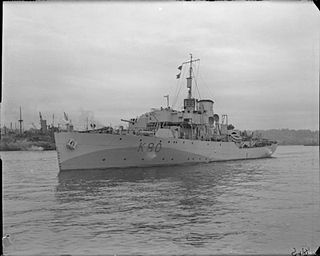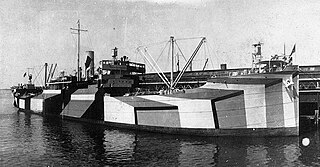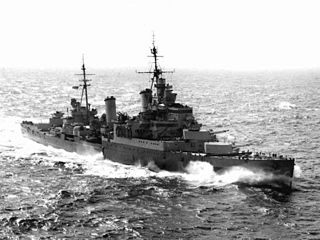
HMS Bluebell was a Flower-class corvette that served in the Royal Navy in World War II. Ordered from Fleming & Ferguson of Paisley, Scotland on 27 July 1939, she was launched on 24 April 1940 and commissioned in July 1940. She served in the Atlantic, Mediterranean and Arctic campaigns, escorting several convoys to Russia, and also took part in the invasions of Sicily and France. She was torpedoed and sunk by U-711 under the command of Hans-Günther Lange in the Kola Inlet on 17 February 1945 while escorting the convoy RA-64 from Murmansk. Only one member of her crew survived.
During the Second World War designated convoy rescue ships accompanied some Atlantic convoys to rescue survivors from ships that had been attacked. Rescue ships were typically small freighters with passenger accommodation converted to rescue service. This involved enlarging galley and food storage areas and providing berthing and sanitary facilities for approximately 150 men. Preparation for service included the installation of scrambling nets along the sides, and the substitution of boats suitable for open sea work for normal lifeboats. Rescue ships normally included a small operating room for an embarked naval doctor and sick bay staff.

Convoy PQ 16 was an Arctic convoy sent from Great Britain by the Western Allies to aid the Soviet Union during the Second World War. It sailed on 25 May 1942, reaching the Soviet northern ports on 30 May after five days of air attacks that left seven ships sunk and three damaged; 25 of the ships arrived safely.
Convoy PQ 1 was the second of the Arctic Convoys of World War II by which the Western Allies supplied material aid to the Soviet Union in its fight with Nazi Germany. The convoy sailed from Hvalfiord in Iceland on 29 September 1941 and arrived at Archangelsk on 11 October 1941.
Convoy PQ 2 was the third of the Arctic Convoys of World War II by which the Western Allies supplied material aid to the Soviet Union in its fight with Nazi Germany. The convoy sailed from Liverpool on 13 October 1941 and arrived safely at Archangelsk on 30 October 1941.
Convoy PQ 3 was the fourth of the Arctic Convoys of World War II by which the Western Allies supplied material aid to the Soviet Union in its fight with Nazi Germany. The Convoy sailed from Hvalfjord, Iceland on 9 November 1941 and arrived at Archangelsk on 22 November 1941.
Convoy PQ 4 was the fifth of the Arctic Convoys of World War II by which the Western Allies supplied material aid to the Soviet Union in its fight with Nazi Germany. The Convoy sailed from Hvalfjord, Iceland on 17 November 1941 and arrived at Archangelsk on 28 November 1941.
SS River Afton was a steam merchant built in 1935 by Lithgows, of Port Glasgow, Scotland and homeported in Glasgow. She was operated by Campbell Brothers & Co, Newcastle-upon-Tyne. She was named after the River Afton in Ayrshire, Scotland.
Convoy PQ 6 was the seventh of the Arctic convoys of World War II by which the Western Allies supplied material aid to the Soviet Union in its fight with Nazi Germany. The convoy sailed from Hvalfjörður, Iceland, on 8 December 1941 and arrived at Murmansk on 20 December 1941.
Convoy PQ 7 was the eighth of the Arctic Convoys of the Second World War by which the Western Allies supplied material aid to the Soviet Union in its fight with Nazi Germany. The Convoy was in two parts: PQ 7a sailed from Hvalfjörður, Iceland on 26 December 1941 and arrived at Murmansk on 12 January 1942. PQ 7b sailed from Hvalfjord, Iceland on 31 December 1941 and arrived in Murmansk on 11 January 1942.
SS Empire Morn was a 7,092-ton CAM ship that was built in 1941. She saw service on a number of trade routes during the Second World War, making several crossings of the North Atlantic as well as voyages to Russia and Africa. She was badly damaged after hitting a mine in 1943, and spent the rest of the war laid up as a hulk. She was subsequently sold and repaired, returning to service for several companies after the war, under the names San Antonio and Rio Pas before being sold for scrapping in 1973.
Convoy PQ 18 was the last of the PQ/QP series of arctic convoys during World War II, bound from US and British ports via Reykjavík to the Barents Sea and White Sea ports of the Soviet Union, particularly Murmansk and Archangel. The convoy sailed on 2 September 1942 and arrived three weeks later on 21 September 1942. It was opposed by German sea and air forces based in occupied Norway.

Convoy PQ 15 was an Arctic convoy sent from Iceland by the Western Allies to aid the Soviet Union during World War II. It sailed in late April 1942, reaching the Soviet northern ports after air attacks that sank three ships. Twenty-two ships arrived safely.

Convoy PQ 14 was an Arctic convoy sent from Great Britain by the Western Allies to aid the Soviet Union during World War II. It sailed in April 1942, reaching Murmansk after air and U-boat attacks that sank one ship, and ice damage that saw 16 vessels returned to port. Seven ships arrived safely.
Convoy PQ 12 was an Arctic convoy sent from Great Britain by the Western Allies to aid the Soviet Union during World War II. It sailed in March 1942, reaching Murmansk despite a sortie against it by the German battleship Tirpitz. All ships arrived safely.
Convoy PQ 11 was an Arctic convoy sent from Great Britain by the Western Allies to aid the Soviet Union during World War II. It sailed in February 1942 and arrived in Murmansk without loss.
Convoys PQ 9 and 10 were Arctic convoys sent from Great Britain by the Western Allies to aid the Soviet Union during World War II. They sailed together in early February 1942 and arrived in Murmansk without loss.

Convoy PQ 8 was an Arctic convoy sent from Great Britain by the Western Allies to aid the Soviet Union during World War II. It sailed in January 1942 and arrived in Murmansk with the loss of one escort sunk, and one ship damaged.
Convoy JW 51A was an Arctic convoy sent from Great Britain by the Western Allies to aid the Soviet Union during World War II. It sailed in December 1942, reaching the Soviet northern ports at the end of the month.
USS LST-35 was an LST-1-class tank landing ship of the United States Navy built during World War II. She was transferred to the Royal Hellenic Navy on 18 August 1943, before being commissioned into the USN, and was renamed Chios.










